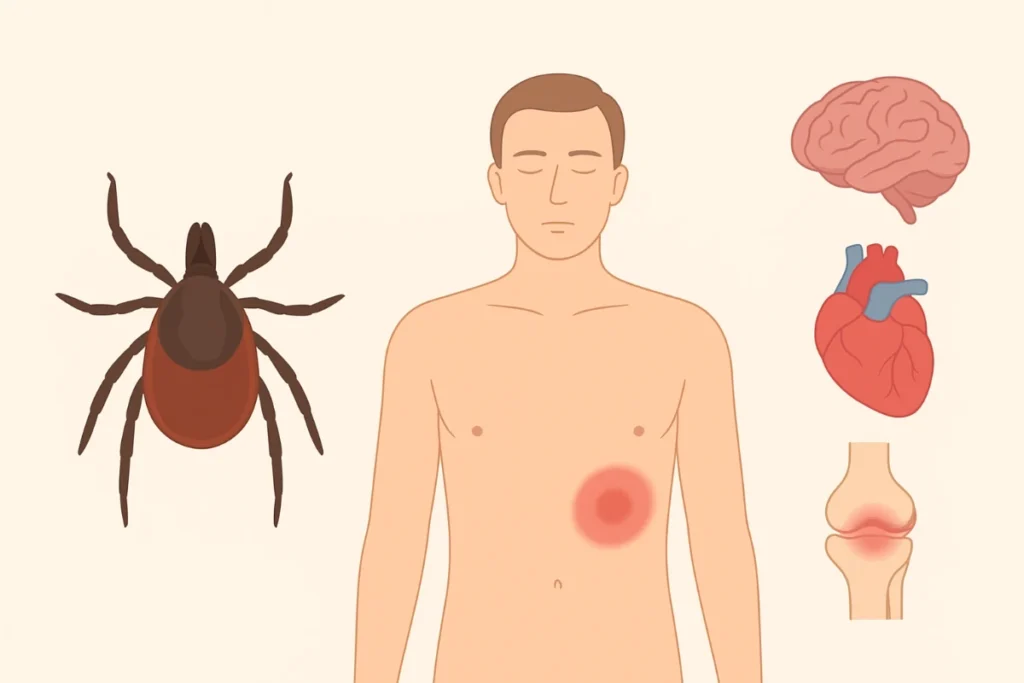What is Lyme disease?
Lyme disease is a bacterial infection caused by the bite of a tiny insect called a tick. The most common culprit is the black-legged tick (deer tick), which carries the Borrelia burgdorferi bacteria. When this infected tick bites a human, the bacteria enter the bloodstream and the infection begins.
The disease was first identified in the 1970s in the town of Lyme, Connecticut, hence the name “Lyme disease.” Today it is a worldwide health concern, especially in the United States, Europe, and some areas of Asia.
The biggest problem is that its initial symptoms seem like the flu (fever, fatigue, headache), due to which people ignore it. If timely treatment is not received, the disease can progress to an advanced stage and affect the joints, nervous system, and heart.
Causes of Lyme Disease
The root cause of tick-borne illness is Borrelia burgdorferi bacteria that live in the tick’s body. These bacteria are transferred when the tick attaches itself to the skin of a human or animal and sucks blood.

Major Causes and Risk Factors:
- Tick Bite: Ticks are found in forested and grassy areas.
- Geographical Region: People living in rural or woodland areas are at greater risk.
- Outdoor Activities: Tick exposure occurs while hiking, gardening, trekking, and camping.
- Pets: Dogs and outside animals have also come into the house.
Early Signs and Symptoms of Lyme Disease
Symptoms of Lyme infection usually appear within 3–30 days. In the early stages, you may notice the following signs:
- Bull’s-eye rash (erythema migrans): This is the most common and unique symptom. There is a red circular rash that slowly expands, with the center being lighter and the outer ring being darker.
- Flu-like symptoms: mild fever, fatigue, chills, and headache.
- Muscle and joint stiffness
- Swollen lymph nodes
But remember, not all patients develop a rash. So, it is wrong to rely only on the rash.
Advanced Symptoms of Untreated Borrelia infection
If Lyme symptoms are not treated in the early stages, the bacteria spreads to different organs of the body. This stage can be dangerous:
- Neurological Issues: Memory loss, difficulty concentrating, facial paralysis (Bell’s palsy), and numbness or tingling sensation.
- Joint Damage: Severe arthritis, swollen joints, chronic joint pain.
- Heart Problems: Irregular heartbeat, dizziness, chest pain (Lyme carditis).
- Mental Health Issues: Anxiety, depression, and sleep disturbances.
This advanced stage can disturb patients for months or years and sometimes becomes chronic Lyme disease, in which symptoms return repeatedly.
Stages of Lyme Disease
Doctors usually divide Lyme disease into 3 stages:
- Stage 1 – Early Localized Infection (3–30 days):
– Rash (bull’s-eye), fever, headache, fatigue. - Stage 2 – Early Disseminated Infection (weeks to months):
– Nervous system involvement, joint pain, multiple rashes. - Stage 3 – Late Persistent Infection (months to years):
– Chronic arthritis, severe neurological damage, heart problems.
How Is Lyme Infection Diagnosed?
Diagnosis is tricky because the rash and symptoms can mimic those of the flu or other diseases. Doctors usually follow these steps:
- Physical Examination: Observing the rash and symptoms.
- Medical History: Asking about tick exposure (did you visit wooded or grassy areas?).
- Blood Tests:
ELISA test—to detect antibodies.
Western Blot test—for confirmation.
Sometimes blood tests come back negative in the early stages; that is why doctors also take rash and exposure history seriously.
Treatment for Borrelia infection
Treatment of this disease is possible, especially if it is diagnosed early.
1. Antibiotics (first-line treatment):
- Adults children: Doxycycline (10–21-day course)
- Pregnant women & young children: Amoxicillin or Cefuroxime
2. Advanced Stage Treatment:
- Other antibiotics (ceftriaxone) are used if there are nervous system or heart effects.
- Supportive care for joint pain (NSAIDs, physiotherapy).
3. Chronic Symptom Management:
Some people still feel fatigue and pain after taking antibiotics; this condition is called post-treatment Lyme disease syndrome (PTLDS). Lifestyle changes and symptomatic treatment are given for this.
Lyme prevention
Because Lyme infection is caused by tick bites, prevention is the best defense.
- Protective Clothing: Wear full sleeves and long pants when going outdoors.
- Tick Repellent: Use DEET- or permethrin-based insect repellent.
- Tick Check: Check your skin, scalp, and pets after outdoor activities.
- Safe Tick Removal: If the tick is stuck, remove it gently with fine-tipped tweezers; do not pull it off.
- Maintain Yard Hygiene: Keep grassy and bushy areas around the house clean.
Myths and Facts About Lyme Disease
- Myth: Borrelia infection occurs only when there is a rash.
Fact: Not all patients develop a rash. - Myth: it is only in that.
Fact: Cases are also reported in regions of Europe and Asia. - Myth: If the symptoms are mild, then treatment is not required.
Fact: Timely treatment is necessary at every stage; otherwise, long-term damage may occur.
When to See a Doctor?
- If you have a rash or flu-like symptoms after outdoor activity.
- If severe fatigue, body aches, or headaches begin after a tick bite.
- If neurological or heart problems suddenly develop.
Living with Bacterial tick disease (Patient Perspective)
Those who face late-stage Tick-borne illness have a significant impact on their quality of life. They often have fatigue, pain, and concentration problems. Therefore, it is very important for both the patient and family to maintain awareness and a support system.
Doctors recommend:
- Balanced diet and hydration.
- Gentle exercise or physiotherapy for joints.
- Stress management through meditation and counselling.
FAQs: How to Prevent Tick-Borne Illness
Q1: Is Lyme disease contagious?
Ans: No, it does not spread from person to person. It only spreads through a simple bite.
Q2: If it happens once, can it happen again?
Ans: Yes, reinfection is possible if you get bitten by a tick again.
Q3: Can I get the disease even if I don’t have a rash?
Ans: Of course, the rash occurs only in 70–80% of cases.
Conclusion
Lyme disease starts with a small tick bite, but if ignored, it can lead to life-threatening complications. The good news is that if diagnosed early and treated with antibiotics, the patient can recover completely.
Prevention is the greatest weapon—with protective clothing, tick repellents, and awareness, you can keep yourself and your family safe.
Also Read: Deadly Vibrio vulnificus Infection Spreads in Florida






